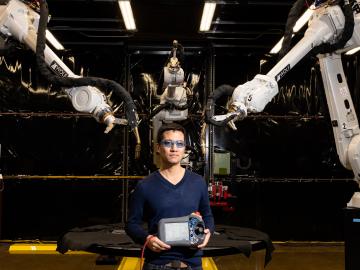
Filter News
Area of Research
- Advanced Manufacturing (6)
- Biology and Environment (6)
- Building Technologies (1)
- Computer Science (2)
- Energy Science (50)
- Energy Sciences (1)
- Fusion and Fission (1)
- Materials (31)
- Materials for Computing (5)
- National Security (7)
- Neutron Science (38)
- Nuclear Science and Technology (11)
- Quantum information Science (3)
- Supercomputing (25)
News Topics
- (-) 3-D Printing/Advanced Manufacturing (33)
- (-) Big Data (12)
- (-) Cybersecurity (7)
- (-) Energy Storage (23)
- (-) Grid (11)
- (-) Machine Learning (8)
- (-) Neutron Science (47)
- (-) Quantum Science (17)
- (-) Space Exploration (4)
- Advanced Reactors (15)
- Artificial Intelligence (9)
- Bioenergy (15)
- Biology (6)
- Biomedical (27)
- Biotechnology (2)
- Buildings (1)
- Chemical Sciences (5)
- Clean Water (3)
- Composites (4)
- Computer Science (53)
- Coronavirus (25)
- Critical Materials (3)
- Environment (32)
- Exascale Computing (3)
- Frontier (1)
- Fusion (17)
- High-Performance Computing (3)
- Isotopes (14)
- Materials (2)
- Materials Science (47)
- Mathematics (2)
- Mercury (2)
- Microscopy (13)
- Molten Salt (6)
- Nanotechnology (26)
- National Security (2)
- Nuclear Energy (41)
- Physics (22)
- Polymers (12)
- Security (10)
- Summit (19)
- Transportation (22)
Media Contacts

Scientists at the Department of Energy’s Oak Ridge National Laboratory have developed a new method to peer deep into the nanostructure of biomaterials without damaging the sample. This novel technique can confirm structural features in starch, a carbohydrate important in biofuel production.

We have a data problem. Humanity is now generating more data than it can handle; more sensors, smartphones, and devices of all types are coming online every day and contributing to the ever-growing global dataset.

OAK RIDGE, Tenn., Feb. 19, 2020 — The U.S. Department of Energy’s Oak Ridge National Laboratory and the Tennessee Valley Authority have signed a memorandum of understanding to evaluate a new generation of flexible, cost-effective advanced nuclear reactors.

Researchers at ORNL demonstrated that sodium-ion batteries can serve as a low-cost, high performance substitute for rechargeable lithium-ion batteries commonly used in robotics, power tools, and grid-scale energy storage.

A novel approach developed by scientists at ORNL can scan massive datasets of large-scale satellite images to more accurately map infrastructure – such as buildings and roads – in hours versus days.

Energy storage startup SPARKZ Inc. has exclusively licensed five battery technologies from the Department of Energy’s Oak Ridge National Laboratory designed to eliminate cobalt metal in lithium-ion batteries. The advancement is aimed at accelerating the production of electric vehicles and energy storage solutions for the power grid.

Peter Wang is focused on robotics and automation at the Department of Energy’s Manufacturing Demonstration Facility at ORNL, working on high-profile projects such as the MedUSA, a large-scale hybrid additive manufacturing machine.

The formation of lithium dendrites is still a mystery, but materials engineers study the conditions that enable dendrites and how to stop them.

Rigoberto “Gobet” Advincula has been named Governor’s Chair of Advanced and Nanostructured Materials at Oak Ridge National Laboratory and the University of Tennessee.

A team from the ORNL has conducted a series of experiments to gain a better understanding of quantum mechanics and pursue advances in quantum networking and quantum computing, which could lead to practical applications in cybersecurity and other areas.


